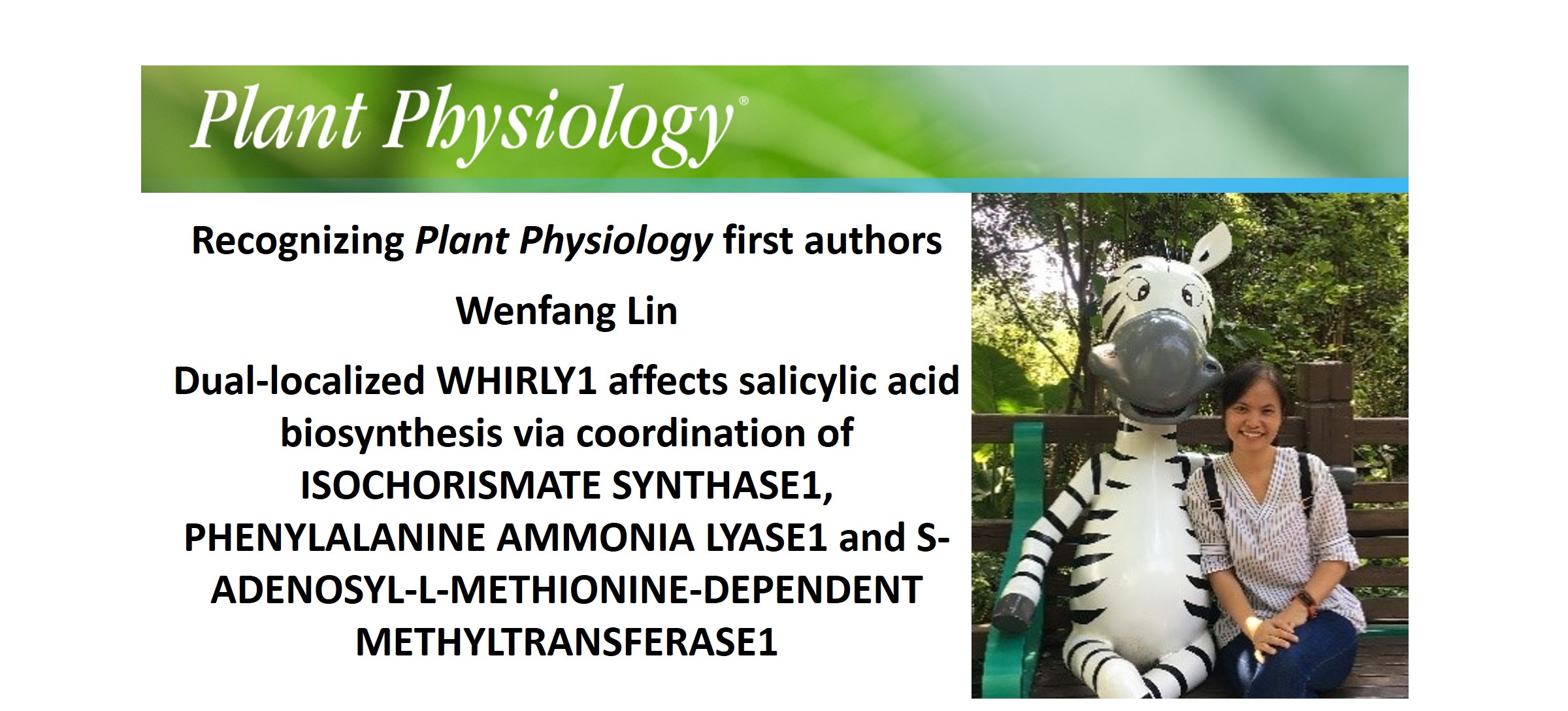Recognizing Plant Physiology authors: Wenfang Lin
 Wenfang Lin, first author of Dual-localized WHIRLY1 affects salicylic acid biosynthesis via coordination of ISOCHORISMATE SYNTHASE1, PHENYLALANINE AMMONIA LYASE1 and S-ADENOSYL-L-METHIONINE-DEPENDENT METHYLTRANSFERASE1
Wenfang Lin, first author of Dual-localized WHIRLY1 affects salicylic acid biosynthesis via coordination of ISOCHORISMATE SYNTHASE1, PHENYLALANINE AMMONIA LYASE1 and S-ADENOSYL-L-METHIONINE-DEPENDENT METHYLTRANSFERASE1
Current Position: Fujian Agriculture and Forestry University, College of Life Science, Lecturer
Education: 2004.09-2007.07, Xiamen University, Master of Developmental Biology, Supervisor: Xueyi Zhu; 2010.09-2017.07, Fujian Agriculture and Forestry University, Doctor of botany, Supervisor: Ying Miao, Wenxiong Lin
Non-scientific Interests: travelling, movies, sports
Brief bio: My doctoral degree is from Fujian Agriculture and Forestry University, and I mainly carry out research work in Professor Miao Ying’s laboratory, focusing on the WHIRLY1 protein dual-located in nuclear and plasmid mediate the H2O2 and plant hormones to regulate aging in Arabidopsis thaliana leaves. During this period, it was found that the distribution of DNA binding protein WHIRLY1 between nucleus and chloroplast would disturb the homeostasis regulation of H2O2 in leaf senescence, and the heterotopic expression of nuclear subtype (nWHY1) could restore the senescence phenotype caused by the increase of H2O2 caused by knockout WHY1 (kowhy1), while plasmid subtype (pWHY1) could not. Exogenous H2O2 treatment reduced nWHY1 distribution and enriched H3K9ac and recruited RNAP II, thereby activating WRKY53 transcription and leading to senescence phenotypes (Lin et al. 2019, Cells). In this paper, the distribution of WHIRLY1 also alters the dynamics of the plant hormone salicylic acid (SA) during plant aging via upstream regulating ICS1, PAL1 and BSMT1 expression, and the feedback of SA interferes the distribution of WHIRLY1 in the chloroplast and the nucleus, with the circulatory integration regulatory network of Arabidopsis during the development or stress-induced aging process. In conclusion, we reveal the molecular mechanism of leaf senescence caused by the change of H2O2 and SA accumulation mediated by the WHIRLY1. Later, we will illustrat an epigenetic point of view how WHIRLY1 regulates plant hormones to interfere with leaf senescence.
姓名:林文芳
现在职位:福建农林大学,生命科学学院,讲师
教育经历:2004.09至2007.07,厦门大学发育生物学硕士,导师:朱学艺副教授;2010.09至2017.07,福建农林大学植物学博士,导师:缪颖教授、林文雄教授
兴趣爱好:旅游、电影、运动
个人简介:本人博士在职就读于福建农林大学,主要在缪颖教授实验室开展研究工作,围绕植物特有的双定位细胞核和质体的WHIRLY1蛋白介导的H2O2及植物激素调控拟南芥叶片衰老分子机制开展相关研究。期间发现DNA结合蛋白WHIRLY1通过上游调控两个过氧化物酶基因PRX33和PRX39的表达, 改变叶片衰老过程H2O2的稳态,核亚型(nWHY1)的异位表达可以恢复敲除WHY1(kowhy1)引起的H2O2增高引起的叶片衰老表型,而质体亚型(pWHY1)不能。外源H2O2处理减少nWHY1分布并富集H3K9ac和RNAP II,进而激活WRKY53转录导致衰老表型 (Lin et al. 2019, Cells)。在这篇文章中,WHIRLY1通过上游调控SA合成酶基因ICS1和PAL1和SA甲基化酶基因BSMT1的表达,改变了植物激素水杨酸(SA)在叶片衰老过程的动态规律,而SA的反馈干预了WHIRLY1蛋白在细胞核与叶绿体的分布。综上,我们揭示了WHIRLY1介导的H2O2和SA积累的改变引起的叶片衰老的分子机制,后续我们将继续围绕WHIRLY1介导植物激素在叶片衰老中的作用,从表观遗传调控角度深度解析其分子机制。



